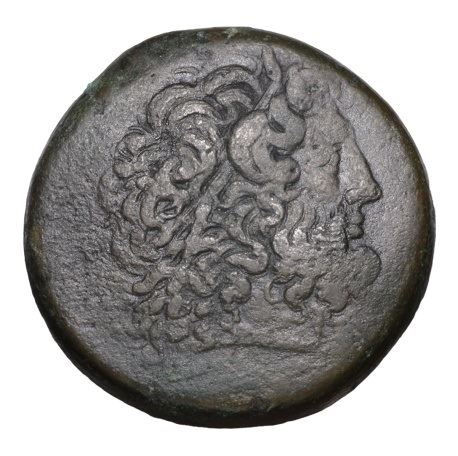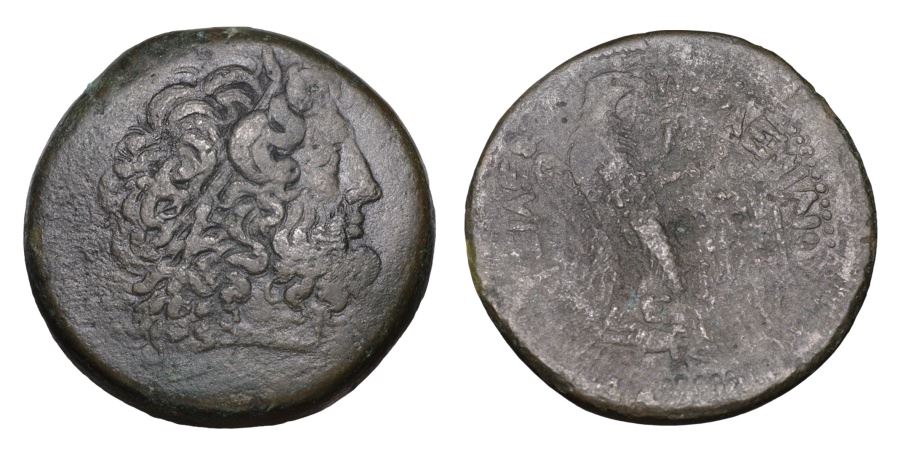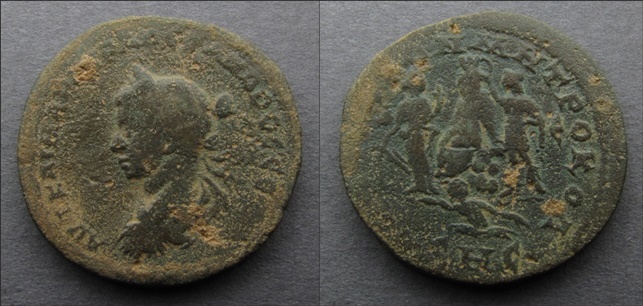The octobol - eight obols - was an ancient Greek denomination struck in both silver and bronze.
The huge Ptolemaic bronze issue weighs between 80 and 96 grams, and some scholars prefer to regard these as heavy bronze drachms (usually 60-75 grams), but we follow the classification of Catherine Lorber (2011).
In silver, the octobol usually weighs between 4.5 and 5.5 grammes, depending on the standard on which it was struck.
The huge Ptolemaic bronze issue weighs between 80 and 96 grams, and some scholars prefer to regard these as heavy bronze drachms (usually 60-75 grams), but we follow the classification of Catherine Lorber (2011).
In silver, the octobol usually weighs between 4.5 and 5.5 grammes, depending on the standard on which it was struck.

(1)
Ptolemy II

An
AE
Octobol
struck 260 - 246 BC
in
Alexandria
Obverse: Diademed head of Zeus-Ammon right
Reverse: ΒΑΣΙΛΣΩΣ ΠΤΟΛΣΜΑΙΟΥ, Eagle standing left, wings open, head right, no symbol between legs
Diameter:
46 mm
Die Orientation: 6 H
Weight: 87.5 g
Die Orientation: 6 H
Weight: 87.5 g
No notes for this coin
Svoronos 412, SNG Cop 141

Obverse: Laureate, draped and cuirassed bust left.
Reverse: Tyche seated left on rocks; to left, another Tyche standing right, holding rudder and cornucopia; to right, emperor standing left, crowning her; below, river-god swimming r.; Δ-E across field; H (denomination) in exergue.
Diameter:
30.71 mm
Die Orientation: 12 H
Weight: 14.65 g
Die Orientation: 12 H
Weight: 14.65 g
A rare left bust coin with none same recorded in acsearch and just one left bust (with shiled) variety recorded in CNG Electronic Auction 181 in 06.02.2008 Lot 238 realized then $260 + buyers fee - and still not the same variety.
As noted in the book by Getzel M. Cohen "The Hellenistic Settlements in Syria, the Red Sea, and North Africa", the statue of Kalliope in the fashion of the Tyche of the city being crowned by Seleukos and Antiochos (Malalas 11.276) reappears - with significant modifications - on coins struck by Severus Alexander. On the reverse of the coins we see Tyche of Antioch in the centre; on the left a standing Tyche, holding rudder and cornucopia; on the right a figure in cuirass, crowning the Tyche of Antioch. The latter figure probably a Roman emperor, undoubtedbly Severus Alexander himself, rather than Seleukos.
SNG Copenhagen 256.
